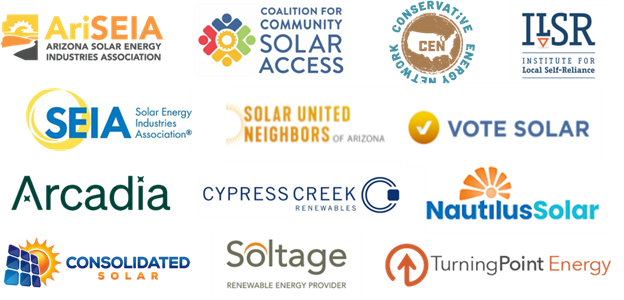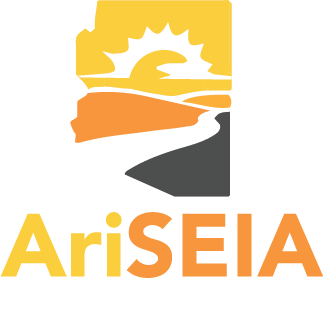|
Arizona Corporation Commission
1200 W. Washington Street Phoenix, AZ 85007 RE: Community Solar, Docket No. E-00000A-22-0103 Madam Chair, Commissioners, Commission Staff, and Interested Stakeholders, The signatories to this letter — a coalition of solar and storage industry partners, including developers, subscriber acquisition and management firms, and advocacy groups — appreciate the Commission and Staff conducting the working group meetings regarding the implementation of a community solar program in Arizona. We believe that a properly constructed community solar program will provide bill savings to electric utility customers, promote electric grid resiliency, and assist Arizona in its transition to clean energy. We are committed to docketing information that will assist in the Commission’s consideration of a proposal for implementation and we look forward to continued participation and discussion in the working group sessions. We were encouraged by the progress made during the Commission’s community solar working group held on August 4, 2022 and appreciate that the next meeting will be a two day working group session held on August 30 and 31. We understand that Staff is still developing the proposed agenda for the August meetings; therefore, we suggest the following topics: bill credit structure and value, eligible subscribers and low- and moderate-income (LMI) subscriber participation, program and project size, project selection, storage, and hosting capacity maps. To the extent that it is helpful to the Staff and other stakeholders, below are potential questions that could be posed for each topic at the next meeting. ● Bill credit structure and value ○ How should the bill credit be structured? ○ Would the resource comparison proxy (RCP) accurately represent the full value of community solar projects? ○ Given the bill credit structure, what is the projected value of the bill credit? ○ What should the term of the bill credit be? ● Eligible subscribers and LMI participation ○ Which customer classes should be eligible for participation in the program? ○ Should there be percentage per-project subscription targets or requirements for certain customer classes? ○ Should there be a required percentage for LMI customer subscription? ○ Should there be a maximum project capacity that “anchor tenants” can subscribe to? ● Program size and project size ○ Should there be a cap on program size? ○ If yes, how should it be constructed? (e.g., percentage of total retail sales vs. number of MW) ○ Should there be a maximum project size or only a requirement that projects connect to the distribution grid? ● Project selection ○ How should projects be selected for participation in the program? (e.g., first-come first-served vs. RFP) ○ What type of project maturity milestones should be required for eligibility in the program, and should those milestones depend on the program size (capped versus uncapped)? ● Storage ○ Should community renewables projects be limited to solar photovoltaic systems, potentially paired with storage? ● Hosting capacity maps ○ Has Arizona Public Service (APS) completed a hosting capacity study and if so, how do the results compare to what would be needed for program implementation? ○ Does APS have hosting capacity maps and if so, how are they to be used by developers? ○ Are there recommended examples of hosting capacity maps in other states? ○ What types of data should be included in hosting capacity maps and how often should they be updated? Further, as was requested at the August 4th working group meeting, we have provided as Attachment A an illustrative example of cash flows for a community solar program, sample or redacted bills as Attachment B from Minnesota and New York, and sample contracts from Nautilus and Arcadia as Attachment C. We appreciate the opportunity to address these important concerns. We look forward to continuing to engage in the working group process to develop a successful community solar program in Arizona. Respectfully, Autumn Johnson Executive Director Arizona Solar Energy Industries Association (520) 240-4757 [email protected] Salar Naini Executive Vice President, Business Development Turning Point (480) 330-1245 [email protected] Justin Biltz Director, Policy & Strategy, Community-Scale Markets Cypress Creek Renewables (330) 515-1564 [email protected] Bret Fanshaw Arizona Program Director | West Region Director Solar United Neighbors (602) 962-0240 [email protected] Angela Navarro Head of State Regulatory Affairs Arcadia (352) 262-8201 [email protected] Kevin Cray Mountain West Regional Director Coalition for Community Solar Access (CCSA) (303) 819-3457 [email protected] Maria McCoy Research Associate, Energy Democracy Institute for Local Self-Reliance (612) 808-0688 [email protected] Sara Birmingham Senior Director of State Affairs Solar Energy Industries Association (415) 385-7240 [email protected] Joy Crossman Director of Development Soltage, LLC (201) 559-6243 [email protected] Kate Bowman Interior West Regulatory Director Vote Solar (703) 674-8637 [email protected] Landon Stevens Director of Policy Conservative Energy Network (480) 338-9767 [email protected] Scott Risley Executive Director of Public Policy Nautilus Solar (928) 925-5972 [email protected] Christopher Mejia Founder Consolidated Solar (717) 884-2204 [email protected]
0 Comments
Leave a Reply. |
AriSEIA NewsKeep up with the latest solar energy news! Archives
July 2024
Categories
All
|
NEWS
See what AriSEIA is up to on the policy front.
The Arizona Solar Energy Industries Association (AriSEIA) is a 501(c)(6) non-profit trade association representing the solar, storage, and electrification industry, solar-friendly businesses, and others interested in advancing complementary technologies in Arizona. The group's focus is on education, professionalism and promotion of public policies that support deployment of solar, storage, and electrification technologies and renewable energy job growth and creation. |
FOLLOW Us |
Copyright © 2019 AriSEIA - All Rights Reserved


 RSS Feed
RSS Feed
